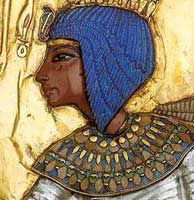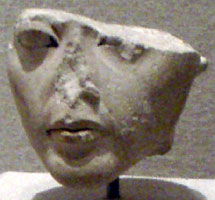
Ankhesenamun lived during the Amarna period of ancient Egypt. Her name means “She lives through Amun” (or “Living through Amun”). However, this is the name she took once the traditional gods had been returned to favour following the Atenist period initiated by her father Akhenaten. She was initially known as Ankhesenpaaten, meaning “She lives through the Aten” or “Living through the Aten”.
It is thought that Ankhesenamun was only thirteen years old when she married Tutankhamun and he was only eight years old. Despite this, they seem to have been a close couple who were depicted enjoying each others company – possibly because they had grown up together and so enjoyed a genuine friendship.
It is largely agreed that she was the third daughter of Akhenaten and Nefertiti and so she may have also been the half-sister of Tutankhamun (by a different mother). It seems that she was born in Thebes (before Akhenaten left the city) but grew up in Akhetaten (the city founded by her father for his god – the Aten) before returning to Thebes when Tutankhamun restored the old gods. There is some indication that Akhenaten may have married Ankhesenamun in year fifteen of his reign (and her two elder sisters at some point before this) and may even have fathered children with them.

These children are proposed to have been named after their mothers with the addition of the epithet “ta sherit” (meaning the younger) and so Ankhesenpaaten ta sherit (who was born when she was only twelve) may have been her daughter by either Akhenaten or Smenkhare. However, it is also possible that Ankhesenpaaten ta sherit was the daughter of Kiya (a minor wife of Akhenaten). Ankhesenamun may have been the Great Wife of Akhenaten for a short period after the death of Nefertiti. She may also have been married to Smenkhare (the successor of Akhenaten) before he too died. She then married Tutankhamun to confirm his status as the next pharaoh.

Tutankhamun and Ankhesenamun ruled Egypt together for around ten years and Ankhesenamun bore him two daughters. Unfortunately, both were born prematurely and died shortly after birth. Their tiny mummies were buried with Tutankhamun in his tomb.
After Tutankhamun’s death, Ankhesenamun was married to Ay (who was Tutankhamun’s vizier and possibly also her grandfather). A glass ring records this marriage but there is no other supporting evidence as she is not recorded as Ay’s wife on any monuments so far recovered. This marriage would have confirmed Ay’s position as Tutankhamun’s successor and may well have been against her will.
There is some evidence that Ankhesenamun wrote a letter to King Suppiluliumas of the Hittites requesting that he send one of his sons to become her husband (and therefore the pharaoh of Egypt).
Ankhesenamun disappeared shortly after the death of Tutankhamun and is not mentioned in the tomb of Ay (which is rather strange as it was probably his marriage to her which confirmed his position). Instead, his previous wife Tiy is the only woman recorded as Ay’s wife in his tomb.
Ankhesenamun’s tomb has not been discovered but it is possible that KV63 was intended for her use, as clay seal impressions found there include part of her name – “pa-aten”.
- Tutankhamun
- Was Tutankhamun murdered?
- Ay
- Amarna Art
- Amarna Royal Family
- Amarna Religion
- Amarna Letters
Copyright J Hill 2010